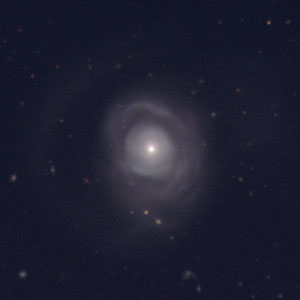20 June 2014
The nucleus of galaxy NGC 5548, which contains a region of powerful X-ray light surrounding the galaxy’s central black hole, has been obscured by a fast-flowing stream of gas. Such behaviour, which is rarely seen in the heart of this type of galaxy, casts new light on the poorly-understood processes governing the interaction between galaxies and their central black holes.
Published in Science today, the study provides the first direct evidence for the long-predicted shielding process that is needed to accelerate powerful gas streams, or “winds,” to high speeds.
"This is a milestone in understanding the interaction of supermassive black holes and their host galaxies.” says Professor Graziella Branduardi-Raymont, one of the researchers from UCL Mullard Space Science Laboratory (MSSL). She added, “I was delighted when our consortium agreed to focus the campaign on NGC 5548, as I first became interested in this active galaxy almost three decades ago, observing it with the X-ray instruments operating in space at the time.”
In 2013 and 2014 the team including researchers from UCL, University of Cambridge and University of Oxford, led by Dr Jelle Kaastra, SRON Netherlands Institute for Space Research, conducted the most extensive monitoring campaign of an active galaxy ever with major ESA and NASA space observatories: XMM-Newton, the Hubble Space Telescope, Swift, NuSTAR, Chandra, and INTEGRAL.
Megan Whewell, the UCL MSSL PhD student who worked on the study said: “The journey from receiving unexpected data to building a coherent theory of the obscuration has been an incredibly exciting one. Being part of this international research effort at an early stage in my career has been invaluable in understanding the process of scientific discovery.”
All big galaxies have supermassive black holes at their centres, but most are dormant as they have very little material near them. In some galaxies, however, gas, dust and even stars are close enough to the black hole to fall into it. Astronomers call these ‘active galaxies’, as the matter spiralling into the black hole forms a disk that heats up and shines extremely brightly, emitting radiation, including X-rays and ultraviolet.
The ultraviolet radiation can launch winds outward, which may be so strong that they can blow off gas that would have otherwise fallen onto the black hole, slowing its growth down again. This feedback mechanism means black hole winds can regulate both the growth of a black hole and its host galaxy; however, the winds only come into existence if their starting point is shielded from X-rays. The newly discovered stream of gas in the galaxy NGC 5548 – the first of its kind in one of the best-studied active galaxies – provides this protection, and it appears that the shielding has been going on for at least three years.
Supermassive black holes in the nuclei of active galaxies, such as NGC 5548, are known to expel large amounts of matter through powerful winds of ionised gas. For instance, the persistent wind of NGC 5548, known for two decades, reaches speeds exceeding 1000 km/s. But now a new obscuring wind has arisen, much stronger and faster than the persistent wind.
"The new wind reaches speeds of up to 5,000 kilometres per second but is much closer to the nucleus than the persistent wind,” Kaastra said. "The new gas outflow blocks 90 percent of the low-energy X-rays that come from very close to the black hole, and it obscures up to a third of the region that emits the ultraviolet radiation at a few light-days distance from the black hole."
Because of this shielding, the persistent wind far away from the nucleus receives less radiation and cools down, causing new features to arise in the spectrum of the wind detected, allowing researchers to pinpoint the location of the strongest persistent wind component.
Strong X-ray absorption by ionised gas has been seen in several other sources where it has been attributed to passing clouds, but in this case, combined data from XMM-Newton and Hubble informed the team that it is a fast stream of outflowing gas very close to the nucleus which may originate from the bright disk surrounding the galaxy’s central black hole.















